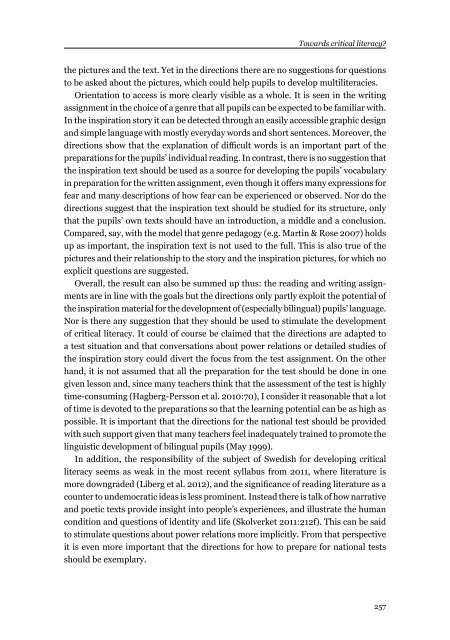Download issue - Umeå universitet
Download issue - Umeå universitet
Download issue - Umeå universitet
You also want an ePaper? Increase the reach of your titles
YUMPU automatically turns print PDFs into web optimized ePapers that Google loves.
Towards critical literacy?<br />
the pictures and the text. Yet in the directions there are no suggestions for questions<br />
to be asked about the pictures, which could help pupils to develop multiliteracies.<br />
Orientation to access is more clearly visible as a whole. It is seen in the writing<br />
assignment in the choice of a genre that all pupils can be expected to be familiar with.<br />
In the inspiration story it can be detected through an easily accessible graphic design<br />
and simple language with mostly everyday words and short sentences. Moreover, the<br />
directions show that the explanation of difficult words is an important part of the<br />
preparations for the pupils’ individual reading. In contrast, there is no suggestion that<br />
the inspiration text should be used as a source for developing the pupils’ vocabulary<br />
in preparation for the written assignment, even though it offers many expressions for<br />
fear and many descriptions of how fear can be experienced or observed. Nor do the<br />
directions suggest that the inspiration text should be studied for its structure, only<br />
that the pupils’ own texts should have an introduction, a middle and a conclusion.<br />
Compared, say, with the model that genre pedagogy (e.g. Martin & Rose 2007) holds<br />
up as important, the inspiration text is not used to the full. This is also true of the<br />
pictures and their relationship to the story and the inspiration pictures, for which no<br />
explicit questions are suggested.<br />
Overall, the result can also be summed up thus: the reading and writing assignments<br />
are in line with the goals but the directions only partly exploit the potential of<br />
the inspiration material for the development of (especially bilingual) pupils’ language.<br />
Nor is there any suggestion that they should be used to stimulate the development<br />
of critical literacy. It could of course be claimed that the directions are adapted to<br />
a test situation and that conversations about power relations or detailed studies of<br />
the inspiration story could divert the focus from the test assignment. On the other<br />
hand, it is not assumed that all the preparation for the test should be done in one<br />
given lesson and, since many teachers think that the assessment of the test is highly<br />
time-consuming (Hagberg-Persson et al. 2010:70), I consider it reasonable that a lot<br />
of time is devoted to the preparations so that the learning potential can be as high as<br />
possible. It is important that the directions for the national test should be provided<br />
with such support given that many teachers feel inadequately trained to promote the<br />
linguistic development of bilingual pupils (May 1999).<br />
In addition, the responsibility of the subject of Swedish for developing critical<br />
literacy seems as weak in the most recent syllabus from 2011, where literature is<br />
more downgraded (Liberg et al. 2012), and the significance of reading literature as a<br />
counter to undemocratic ideas is less prominent. Instead there is talk of how narrative<br />
and poetic texts provide insight into people’s experiences, and illustrate the human<br />
condition and questions of identity and life (Skolverket 2011:212f). This can be said<br />
to stimulate questions about power relations more implicitly. From that perspective<br />
it is even more important that the directions for how to prepare for national tests<br />
should be exemplary.<br />
257

















